1.相交链表
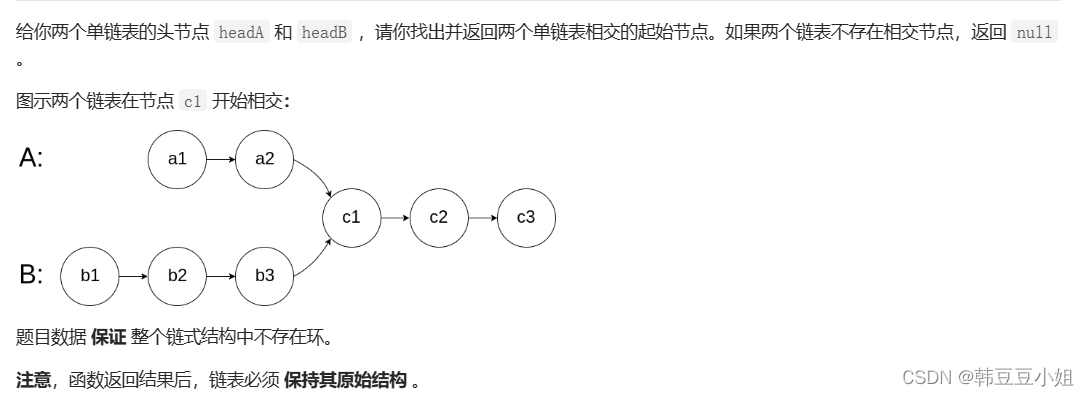
/**
* Definition for singly-linked list.
* struct ListNode {
* int val;
* ListNode *next;
* ListNode(int x) : val(x), next(NULL) {}
* };
*/
class Solution {
public:
ListNode *getIntersectionNode(ListNode *headA, ListNode *headB) {
ListNode *longList, *shortList;
int interval=0;
ListNode *p = new ListNode(0);
ListNode *q = new ListNode(0);
p->next = headA;
q->next = headB;
// 计算链表的长度
int lenA = ListLenght(p);
int lenB = ListLenght(q);
if(lenA>lenB){
longList = p;
shortList = q;
interval = lenA-lenB;
}
else{
longList = q;
shortList = p;
interval = lenB-lenA;
}
//将长的那一方进行移动
while(interval--){
longList = longList->next;
}
//找到两者相交的地方
while(longList->next){
// cout<<longList->next->val;
if(longList->next==shortList->next){
return longList->next;
}
longList = longList->next;
shortList = shortList->next;
}
return NULL;
}
int ListLenght(ListNode *head){
ListNode *p = head;
int count = 0;
while(p->next){
count++;
p = p->next;
}
return count;
}
};
/**
* Definition for singly-linked list.
* struct ListNode {
* int val;
* ListNode *next;
* ListNode() : val(0), next(nullptr) {}
* ListNode(int x) : val(x), next(nullptr) {}
* ListNode(int x, ListNode *next) : val(x), next(next) {}
* };
*/
class Solution {
public:
ListNode* reverseList(ListNode* head) {
ListNode *p = new ListNode(0); //创建头节点
p->next = head;
ListNode *q = p->next;
p->next=nullptr;
while(q){ //利用头插法
ListNode *temp = q->next;
q->next = p->next;
p->next = q;
q=temp;
}
return p->next;
}
};
/**
* Definition for singly-linked list.
* struct ListNode {
* int val;
* ListNode *next;
* ListNode() : val(0), next(nullptr) {}
* ListNode(int x) : val(x), next(nullptr) {}
* ListNode(int x, ListNode *next) : val(x), next(next) {}
* };
*/
class Solution {
public:
ListNode* mergeTwoLists(ListNode* list1, ListNode* list2) {
ListNode *ans = new ListNode(0); //创建结果链表的头节点
ListNode *res = ans; //尾部结点
ListNode *p = list1, *q = list2;
while(p && q){
if(p->val < q->val){
res->next = p;
p = p->next;
}
else{
res->next = q;
q = q->next;
}
res = res->next;
}
ListNode *rest; //判断是否有盈余
rest = (p==nullptr)?q:p;
while(rest){
res->next = rest;
rest = rest->next;
res = res->next;
}
res->next = nullptr; //最后一个结点的尾部置为null
return ans->next;
}
};
/**
* Definition for singly-linked list.
* struct ListNode {
* int val;
* ListNode *next;
* ListNode() : val(0), next(nullptr) {}
* ListNode(int x) : val(x), next(nullptr) {}
* ListNode(int x, ListNode *next) : val(x), next(next) {}
* };
*/
class Solution {
public:
ListNode* deleteDuplicates(ListNode* head) {
if(!head || !head->next){
return head;
}
ListNode *head1 = new ListNode();
head1->next = head;
ListNode *p = head1->next;
ListNode *q = p->next;
while(q){
if(q->val == p->val){
q=q->next;
p->next = q;
}
else{
p = p->next;
q = q->next;
}
}
p->next = nullptr;
return head1->next;
}
};
/**
* Definition for singly-linked list.
* struct ListNode {
* int val;
* ListNode *next;
* ListNode() : val(0), next(nullptr) {}
* ListNode(int x) : val(x), next(nullptr) {}
* ListNode(int x, ListNode *next) : val(x), next(next) {}
* };
*/
class Solution {
public:
ListNode* removeNthFromEnd(ListNode* head, int n) {
ListNode *pre = new ListNode(0);
pre->next = head;
ListNode *p = pre;
ListNode *q = p->next;
int len = listLen(pre);
int index = len-n;
int k = 0;
while(q && k!=index){
k++;
p->next = q;
p = p->next;
q = q->next;
}
p->next = q->next;
return pre->next;
}
//计算带有头节点的链表的长度
int listLen(ListNode *head){
ListNode *p = head->next;
int k = 0;
while(p){
k++;
p = p->next;
}
return k;
}
};
/**
* Definition for singly-linked list.
* struct ListNode {
* int val;
* ListNode *next;
* ListNode() : val(0), next(nullptr) {}
* ListNode(int x) : val(x), next(nullptr) {}
* ListNode(int x, ListNode *next) : val(x), next(next) {}
* };
*/
class Solution {
public:
ListNode* swapPairs(ListNode* head) {
if(!head || !head->next){
return head;
}
ListNode *L = new ListNode(0);
L->next = head;
ListNode *pre = L;
ListNode *p = head;
ListNode *q = p->next;
while(p && q){
ListNode *p1 = q->next;
pre->next = q;
pre = pre->next;
pre->next = p;
pre = pre->next;
p = p1;
if(p && p->next){
q = p->next;
}
else{
break;
}
}
if(p){
pre->next = p;
pre = pre->next;
}
pre->next = nullptr;
return L->next;
}
};
7.链表求和
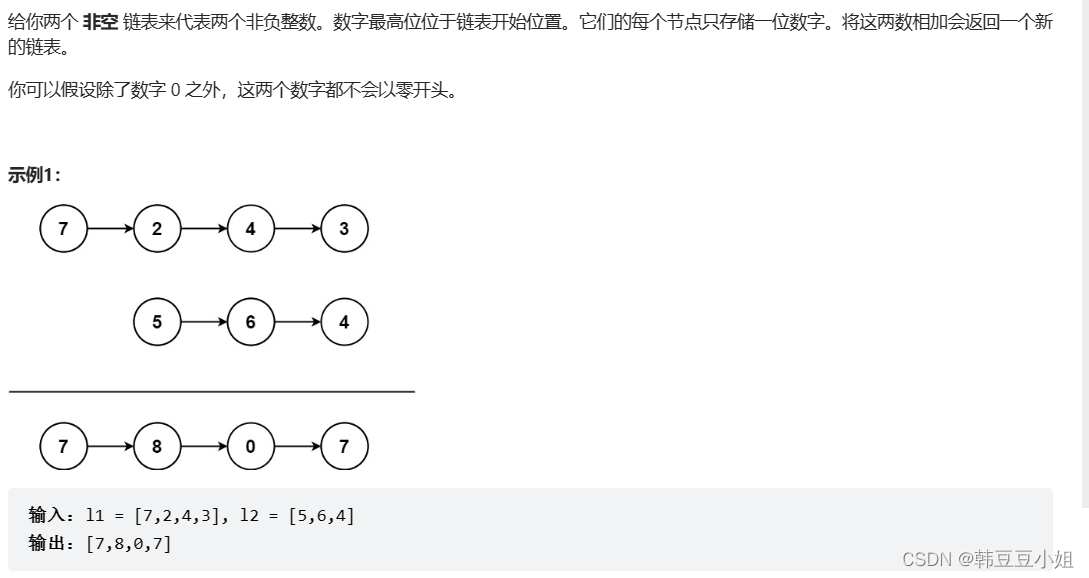
/**
* Definition for singly-linked list.
* struct ListNode {
* int val;
* ListNode *next;
* ListNode() : val(0), next(nullptr) {}
* ListNode(int x) : val(x), next(nullptr) {}
* ListNode(int x, ListNode *next) : val(x), next(next) {}
* };
*/
class Solution {
public:
ListNode* addTwoNumbers(ListNode* l1, ListNode* l2) {
ListNode *p1 = new ListNode(0);
p1->next = l1;
ListNode *p2 = new ListNode(0);
p2->next = l2;
p1 = reverseList(p1);
p2 = reverseList(p2);
int cur = 0;
ListNode *res = new ListNode(0);
ListNode *p = p1->next;
ListNode *q = p2->next;
ListNode *pp;
while(p && q){
int temp = (p->val +q->val+cur);
cur = temp/10;
p->val = temp%10;
pp = p->next;
p->next = res->next;
res->next = p;
p = pp;
q = q->next;
}
if(q){
p=q;
}
while(p){
int temp = p->val+cur;
p->val = temp % 10;
cur = temp /10;
pp = p->next;
p->next = res->next;
res->next = p;
p = pp;
}
if(cur>0){
ListNode *last = new ListNode(cur);
last->next = res->next;
res->next = last;
}
return res->next;
}
//将带有头结点的链表逆序
ListNode* reverseList(ListNode* head){
ListNode *pre = head;
ListNode *p = pre->next;
pre->next = nullptr;
while(p){
ListNode *q = p->next;
p->next = pre->next;
pre->next = p;
p = q;
}
return pre;
}
};
8.回文链表
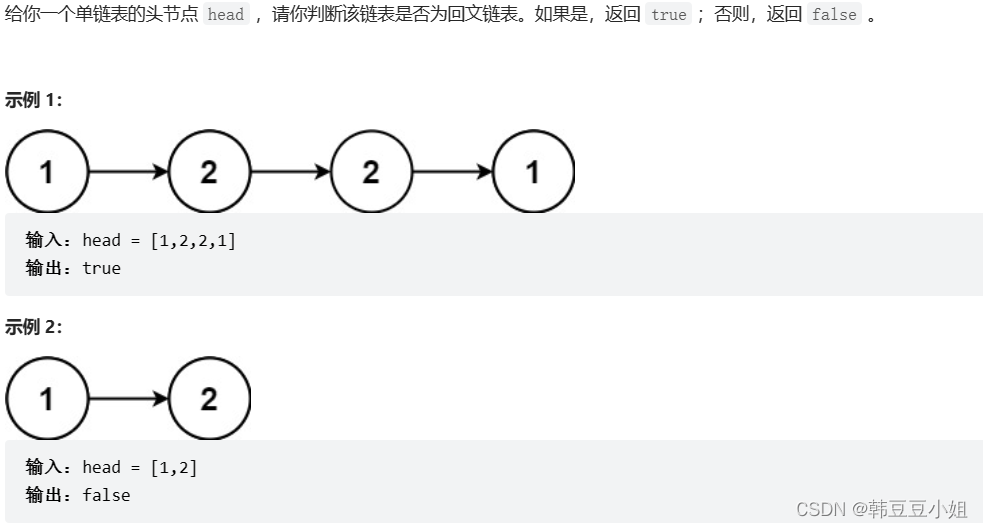
/**
* Definition for singly-linked list.
* struct ListNode {
* int val;
* ListNode *next;
* ListNode() : val(0), next(nullptr) {}
* ListNode(int x) : val(x), next(nullptr) {}
* ListNode(int x, ListNode *next) : val(x), next(next) {}
* };
*/
class Solution {
public:
bool isPalindrome(ListNode* head) {
if(!head || !head->next) return true;
stack<int> s;
ListNode *p = head;
//计算链表的长度
int len = 0;
while(p){
len++;
p = p->next;
}
int mid = len/2;
int count = 0;
p = head;
while(p){
count++;
if(count<=mid){
s.push(p->val);
if(count==mid && len%2==1){
p = p->next;
count++;
}
}
else{
if(s.top()!=p->val) return false;
else{
s.pop();
}
}
p = p->next;
}
if(s.empty()) return true;
else
return false;
}
};
9.分隔链表
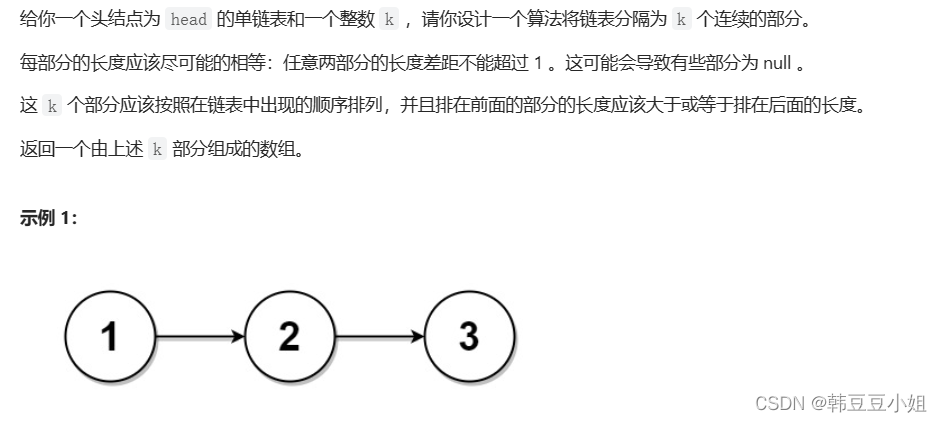
/**
* Definition for singly-linked list.
* struct ListNode {
* int val;
* ListNode *next;
* ListNode() : val(0), next(nullptr) {}
* ListNode(int x) : val(x), next(nullptr) {}
* ListNode(int x, ListNode *next) : val(x), next(next) {}
* };
*/
class Solution {
public:
vector<ListNode*> splitListToParts(ListNode* head, int k) {
//计算链表长度
ListNode *p = head;
int len = 0;
while(p){
len++;
p = p->next;
}
int ave = len/k;
int rest = len%k;
vector<ListNode *> res(k);
p = head;
for(int i=0;i<k;i++){
res[i] = p;
ListNode *tail = res[i];
ListNode *q;
for(int j=1;j<=ave;j++){
q = p->next;
tail->next = p;
tail = tail->next;
p = q;
}
if(rest){
q = p->next;
tail->next = p;
tail = tail->next;
rest--;
p = q;
}
if(tail)
tail->next = nullptr;
}
return res;
}
};
10.链表元素按奇偶聚集
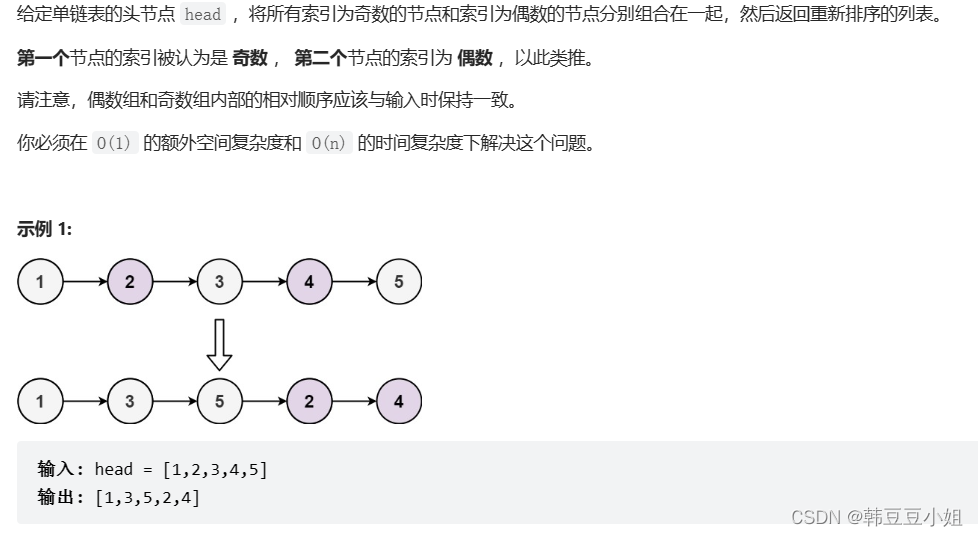
/**
* Definition for singly-linked list.
* struct ListNode {
* int val;
* ListNode *next;
* ListNode() : val(0), next(nullptr) {}
* ListNode(int x) : val(x), next(nullptr) {}
* ListNode(int x, ListNode *next) : val(x), next(next) {}
* };
*/
class Solution {
public:
ListNode* oddEvenList(ListNode* head) {
if(!head || !head->next) return head;
ListNode *Dtail = head;
ListNode *Otail = head->next;
ListNode *p = Dtail;
ListNode *q = head->next;
ListNode *t = q->next;
while(t && t->next){
ListNode *temp = t->next->next;
p->next = t;
p=p->next;
q->next = t->next;
q = q->next;
t = temp;
}
if(t){
p->next = t;
p = p->next;
}
p->next = Otail;
q->next = nullptr;
return Dtail;
}
};





 该文提供了一系列关于链表操作的C++实现,包括查找两个链表的交点、反转链表、合并两个有序链表、删除重复节点、删除倒数第n个节点、两两交换链表中的节点、链表求和、判断回文链表以及按奇偶分割链表等。
该文提供了一系列关于链表操作的C++实现,包括查找两个链表的交点、反转链表、合并两个有序链表、删除重复节点、删除倒数第n个节点、两两交换链表中的节点、链表求和、判断回文链表以及按奇偶分割链表等。
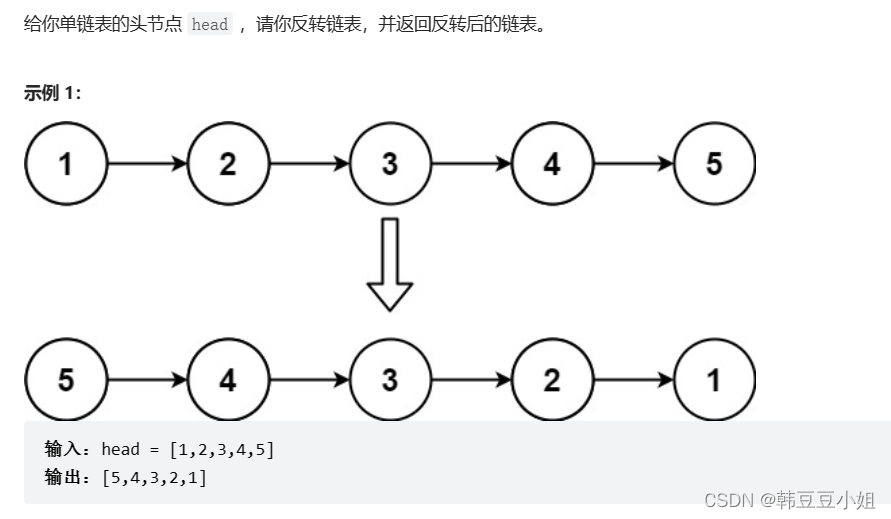
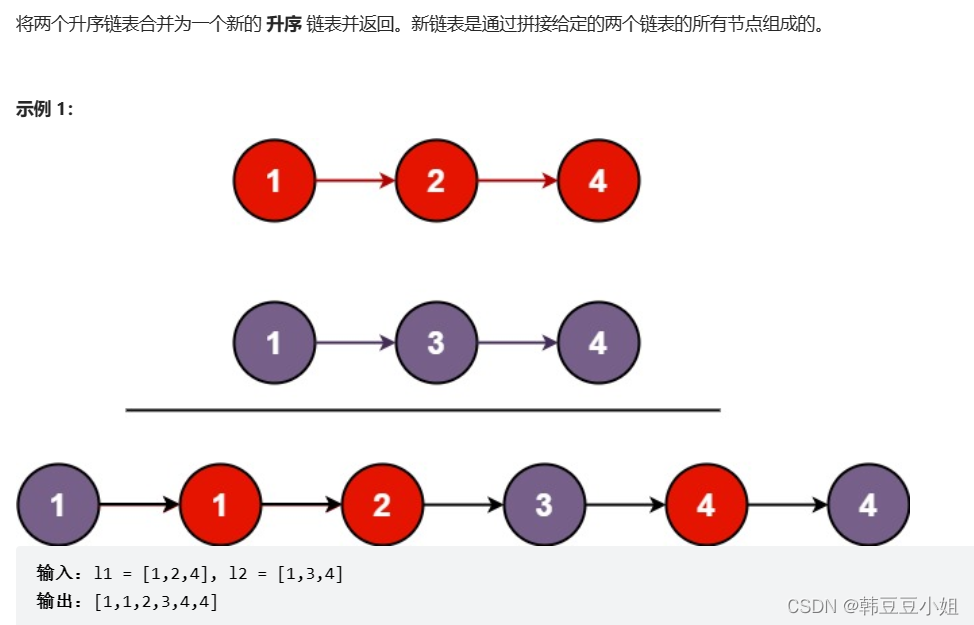
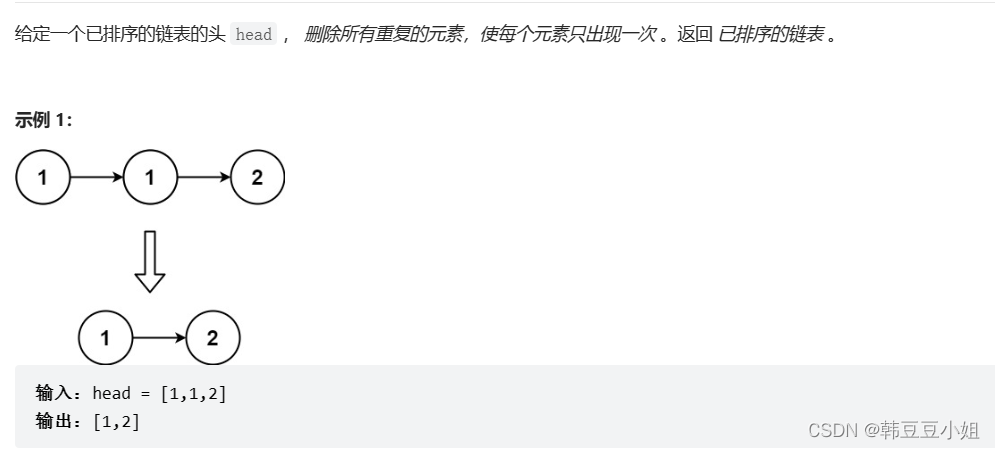

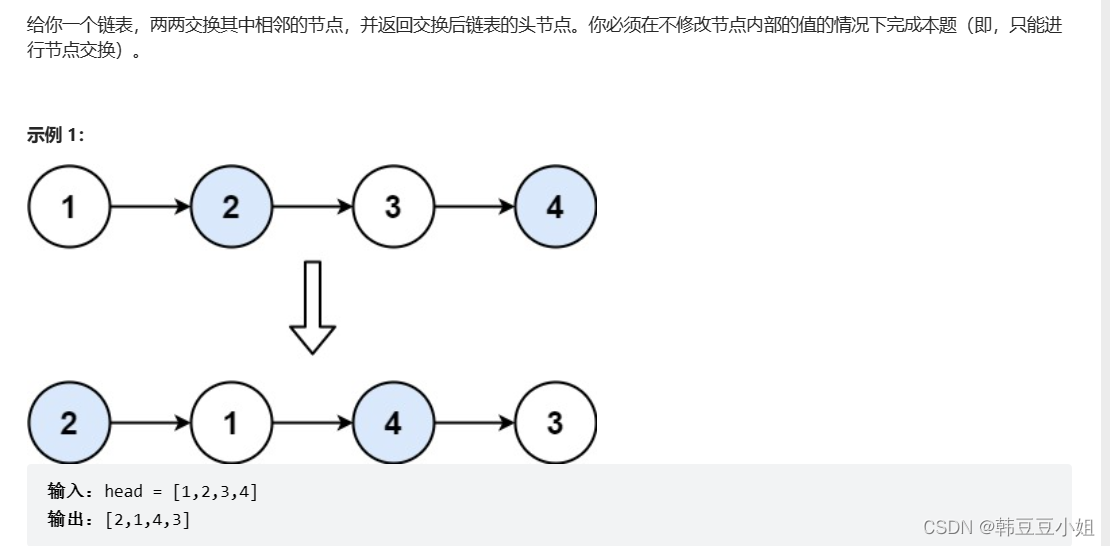
















 979
979

 被折叠的 条评论
为什么被折叠?
被折叠的 条评论
为什么被折叠?








